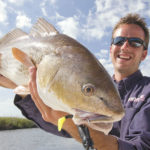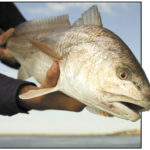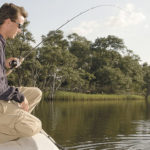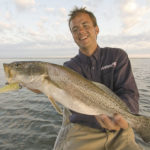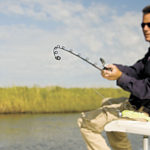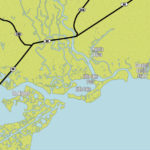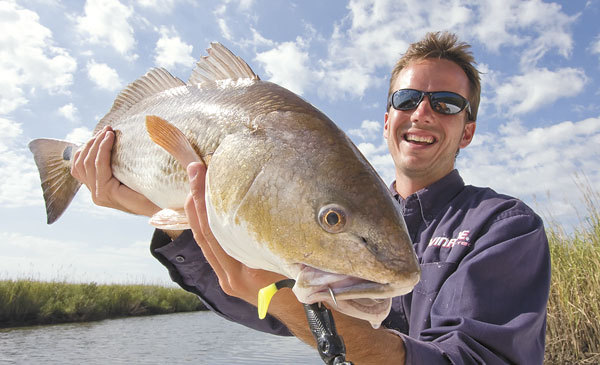
If you want to swing for the fences, go to the Causeway. But if you’re content to load your ice chest with lots of keeper specks and reds, the Lower Pearl River is your autumn paradise.
Lake Pontchartrain regulars are no doubt familiar with what has become known as World Series trout, trophy trout that show up every year around the first pitch of Major League Baseball’s championship series.
These leg-sized specks have made their annual appearance at the 24-mile-long Causeway the last few years, which means their accessibility has been severely limited by anything more than a 10-m.p.h. wind.
As luck would have it for anglers who wake up on an October morning with anything rougher than flat-calm conditions, October is also a banner month for catching speckled trout and redfish at the mouth of the Pearl River, where the effects of the wind, any wind, are marginal at worst.
“You can stay protected over there in that river, and that’s something you can’t do on the Causeway,” said veteran Pontchartrain angler Capt. Chas Champagne. “It doesn’t matter if the wind is 15 m.p.h. out of the west, the water will be clean, and you can still fish.”
Although the World Series trout over on the Causeway get more attention, Champagne says there isn’t a better time to fish the mouth of the Pearl than October. Due to the fact that the river will be as low and clear as it’s going to be all year, saltwater fish move in by the thousands, and this natural border between Louisiana and Mississippi becomes a miniature version of the Mississippi River delta.
“When the river falls,” Champagne said, “fish drive into the east and west branches of the Pearl, and the absolute best conditions for fishing is right after a cold front when the water falls out even more. When you combine that with a falling tide, you’ve got a place where you can make a great day on the water.”
Champagne pointed out that the unofficial dividing line between freshwater and saltwater fishing is around the Highway 90 bridges about four or five miles north of the Rigolets. Although he’s caught redfish as far north as the I-10 bridge, that is more a rarity than a definite possibility.
“You definitely won’t catch your limit of reds up that far,” added Capt. Steve Wicks (985-259-2304) who takes his charter customers inside the Pearl River when the action heats up during the fall. “But from the Highway 90 bridges south, you can find reds and trout spread out in all the channels, bayous, creeks and bays.”
They don’t stay spread out the entire fall, though. In fact, the fish don’t stay spread out for an entire day because when the tide starts to fall, speckled trout and redfish jam up in the mouths of the passes that dump into open areas like Mud Lake and the mouths of the bayous that fall into the main river channels.
Taking into consideration that there are hundreds of these little cuts all over the system, it means that anglers can just about catch fish no matter which part of the lower Pearl they decide to fish. Whether you target the speckled trout or redfish, the techniques these two anglers employ to catch their fish work for you if you practice what they preach.
Speckled trout
According to Champagne, there are two main ways to fish the trout. The first, which is probably the most popular way for most anglers, is to fish the Mud Lake area right off the Rigolets. This is a shallow lake that’s sometimes called Little Lake, and all of the different branches of the Pearl River dump into it one way or another. It proves to be a good staging grounds of sorts for fish that eventually push their way farther north into the main river channels.
“We see birds working out there quite a bit,” Champagne said, “and most people fish it with some kind of plastic under a popping cork. The swimming tails like the Hybrids and Dudleys work well, but a plastic shrimp can be a good choice because those trout out there are pushing those shrimp to the surface, and that’s what the birds are eating.”
While the action in Mud Lake can be really good during the early part of October, colder weather toward the end of the month will push the trout into the main passes that are 8 to 15 feet deep. They sometimes gang up on any little drop-offs right off the bank, but Champagne says it isn’t unusual to find them suspended dead in the middle of a canal that might be 50 feet wide.
Wicks agreed and added that this is one of the main reasons the lower Pearl River is what many consider a serious trolling area when it gets really cold.
“There are so many places to fish that the trolling guys have an advantage because they can cover so much water faster than all of us who just go out bumping plastic on the bottom,” said Wicks. “The standard set-up is a MirrOlure with one of the B2 Squids behind it. Most of those guys just ease down the middle of all those passes until they find out where the fish are.”
If you’re not a troller, Champagne says that won’t matter one bit because these stacked-up trout are suckers for any plastic that looks like a pogie because the river gets loaded up with them from July through December.
“My favorite plastics are the Magic Minnow Hybrid with a chartreuse tail and the blue-moon Dudley Bay Chovey with the chartreuse tail,” Champagne said. “Try counting them down and swimming them, crawling them on the bottom and jigging them pretty hard until you figure out how the trout want them.”
Redfish
While the trout are a welcome addition to the fish box during October, Champagne says that for him chasing redfish is what really gets him fired up when fishing the lower Pearl River this month.
The reds have been there since about the middle of August, but Champagne knows they are only going to get more plentiful and concentrate tighter and tighter into bigger schools as temperatures fall.
“The colder it gets, the more pilled up they’ll be on top of each other,” he said. “You may have to fish hard to find them, but when you do find them, it’s going to be easy to catch your limit while sitting in one spot. They really take over this entire system during the fall, and it’s common to catch 40 to 50 during a day once you find them.”
Being grouped up, though, doesn’t necessarily mean the redfish will be in the same place for an extended period of time. According to Champagne, the water changes so frequently that it forces the groups of reds to move around to take advantage of better eating zones. In other words, there are no secret spots.
A recent trip with Champagne proved his point. He had found a pile of reds the day before, but they were about 200 yards down the bank on the next day. A boat fishing anchored beside us probably would have never found these fish because they were in exactly the right spot.
“You go back the next day, and they may be on the opposite bank,” Champagne said. “Or they may be like those fish were and just move down the same bank. If the tide is falling out, they may be all jammed up in the mouth of a cut feeding on all that bait coming out.”
Many anglers stick with live bait for the reds, and two popular choices are shrimp and pogies. In fact, Champagne prefers pogies if he’s going that route because the river is so flooded with them. However, some simple fresh market shrimp will work fine if all you want to target is redfish.
While he thinks live bait is a great way to keep the bite going if the reds quit his plastics, Champagne typically relies only on the fake stuff when redfishing, and he bases his lure choice on the type of bank before him.
“Some banks come out to where they may be only 4 or 5 feet deep 20 yards off the bank,” he said. “Those kinds of banks are great for topwaters and maybe pulling a spinnerbait. But there are some banks that drop from 2 to 20 feet just 10 yards off the shoreline, and that’s where you want to dribble some plastics on the bottom.”
Champagne and Wicks don’t expect to catch many giant trout or redfish in the lower Pearl River, but they do expect to get a lot of bites. Trout average from 13 to 17 inches and the redfish generally run between 16 and 27 inches.
Does the mouth of the Pearl River offer World Series fishing? Well, that depends on what kind of player you are. If you like to swing for the fences with the increased likelihood of striking out, head for the big trout on the Causeway.
However, if you are the kind of player who likes to consistently get hits, there’s no better place to swing your bat this month than the mouth of the Pearl River.
